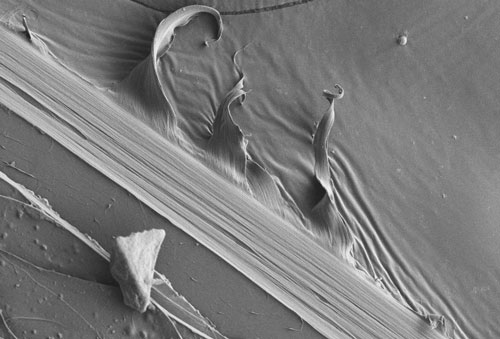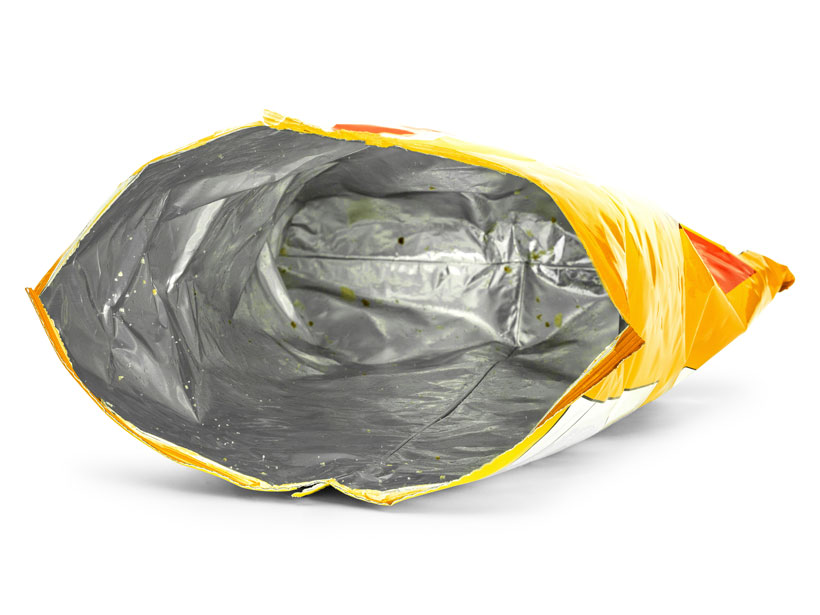Craving potato chips? Opening that bag will release various amounts of microplastics depending on whether it’s torn, cut open with scissors, or pierced with a knife, new research reveals. Other everyday activities—such as cutting tape and twisting open plastic bottlecaps—also shed microscopic plastic debris, the results show. These findings highlight the ubiquity of microplastics in everyday life and serve as a powerful motivator for studies of the potentially detrimental health effects of these tiny bits of plastic, the scientists suggest.
“Almost Everywhere”
Microplastics—pieces of plastic ranging in size from 1 micrometer to 5 millimeters—have been found on glaciers, deep in the ocean, and even in human stool samples. They’re so pervasive because they’re produced both directly (e.g., for some cosmetic products) and indirectly from the fragmentation of larger plastic debris. “Plastic is almost everywhere,” said Cheng Fang, a chemist at the University of Newcastle in Australia.
“We picked up several items from markets [we use in] our daily lives.”
Fang and his colleagues conducted laboratory experiments to better understand how microplastics are generated. They focused on everyday items made of plastic like grocery bags, gloves, packing peanuts, and bottles. “We picked up several items from markets [we use in] our daily lives,” said Fang.
Destruction for Science
The researchers carefully measured the amount of microplastics shed by tearing, scissoring, and cutting (with a knife) different plastic items for 200 seconds. They weighed the microplastics that fell on a quartz crystal microbalance, an extremely sensitive scale. The team found that tearing, scissoring, and cutting generated between roughly 10 billionths and 30 billionths of a gram of microplastics. Given that the average mass of a microplastic particle is roughly 1 billionth of a gram, that translates into a few tens of pieces of microplastics. However, that quantity is likely a gross underestimate of the true number of microplastics generated, the team suggests.
That’s because the quartz crystal microbalance the researchers used had a very small collecting area—about the size of a pencil eraser—and many of the microplastic particles produced were probably small enough to become airborne. On the basis of the geometry of their experimental setup and assuming that microplastics were generated isotropically, the team estimated they were capturing only about one out of every 2,000 particles. That is, each experiment was, in actuality, generating tens of thousands of microplastics.
Watch Out for Cutting
When the researchers compared the amounts of microplastics shed by tearing, scissoring, and cutting polyethylene grocery bags, they found that cutting produced the most debris. That’s perhaps because the forward movement of a knife is less efficient than that of scissors, the team suggests. A dull knife could also pull off larger fragments of plastic, said Fang. “If your knife is not sharp, what you’re cutting is slices of plastic rather than fibers or particles.” Cutting generated about 50% more microplastics than tearing, which was in turn marginally better than scissoring, the team found.
“We know from our use of everyday plastic items that these can easily break or degrade.”
The researchers caution against concluding that cutting always produces the most microplastics, however. That’s because such factors as a plastic’s stiffness, thickness, and density all play roles in how readily it sloughs off bits and pieces, they noted.
Fang and his colleagues also used scanning electron microscopy to image the microplastics produced by scissoring a plastic bottle, tearing a plastic cup, and cutting a plastic bag. They recorded a wide range of particle shapes and sizes, including fibers and fragments.
These results were published in March in Scientific Reports.
“These results are not a surprise,” said Alice Horton, a microplastics researcher at the National Oceanography Centre in Southampton, U.K., not involved in the research. “We know from our use of everyday plastic items that these can easily break or degrade. While we may not necessarily see this degradation with the naked eye, this is likely happening much more regularly than previously thought.”

This work demonstrates how microplastics are produced, but there’s still much more to investigate, said team member Ravi Naidu, an environmental scientist at the University of Newcastle. The health effects of microplastics are really unknown, he said. “Potentially, these can pose risks to people and animals, but there’s no evidence that exposure to microplastics had led to death.” There’s also the open question of exposure pathways, he said. “Is it inhalation, dermal absorption, or is it through the food chain? There’s a whole lot more research that still needs to be done.”
—Katherine Kornei (@KatherineKornei), Science Writer
Citation:
Kornei, K. (2020), Tear, don’t cut, to reduce microplastics, Eos, 101, https://doi.org/10.1029/2020EO143585. Published on 29 April 2020.
Text © 2020. The authors. CC BY-NC-ND 3.0
Except where otherwise noted, images are subject to copyright. Any reuse without express permission from the copyright owner is prohibited.

